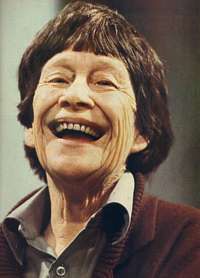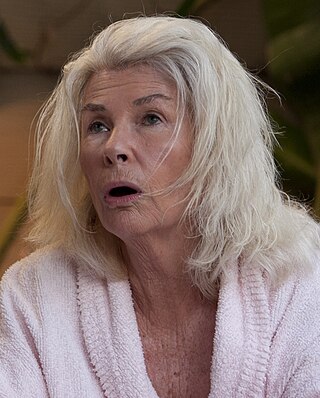Related Research Articles

Sheila Mary Florance was an Australian theatre, television and film actress. She played numerous roles in the Crawford Productions before playing Dossie Rumsay in the rural series Bellbird but became best known internationally for her performance as elderly, alcoholic convict Lizzie Birdsworth in the television series Prisoner.
Reginald Dawson Livermore is an Australian actor, singer, theatrical performer, designer, director, lyricist and writer and former television presenter.

Summer of the Seventeenth Doll is an Australian play written by Ray Lawler and first performed at the Union Theatre in Melbourne on 28 November 1955. The play is considered to be the most significant in Australian theatre history, and a "turning point", openly and authentically portraying distinctly Australian life and characters. It was one of the first truly naturalistic "Australian" theatre productions.
The Australian Elizabethan Theatre Trust (AETT) is an Australian theatre and performing arts company based in Sydney established in 1954. It is today especially known for its music scholarship program.

Robyn Anne Nevin is an Australian actress, director, and stage producer, recognised with the Sidney Myer Performing Arts Awards and the JC Williamson Award at the Helpmann Awards for her outstanding contributions to Australian theatre performance art. Former head of both the Queensland Theatre Company and the Sydney Theatre Company, she has directed more than 30 productions and acted in more than 80 plays, collaborating with internationally renowned artists, including Richard Wherrett, Simon Phillips, Geoffrey Rush, Julie Andrews, Aubrey Mellor, Jennifer Flowers, Cate Blanchett and Lee Lewis.

Madge Winifred Ryan was an Australian actress, known for her stage and film roles in the United Kingdom, including London stage productions of Entertaining Mr Sloane (1964), Philadelphia, Here I Come (1967), and Medea (1993). She also starred in the Broadway production of Summer of the Seventeenth Doll (1958).

Neva Carr Glyn or Neva Carr Glynn was an Australian stage, film and radio actress born in Melbourne to Arthur Benjamin Carr Glyn, a humorous baritone and stage manager born in Ireland, and Marie Carr Glyn, née Marie Dunoon Senior, an actress with the stage name "Marie Avis". She had one half-sister Gwendoline Arnold O'Neill and two half-brothers Sacheverill Arnold Mola and Rupert Arnold Mola. She was named "Neva" after a great-aunt, who was a contralto of some quality. Both spellings of her surname appear in print roughly equally and apparently arbitrarily.
President Wilson in Paris is a 1973 play by Ron Blair set during the Paris Peace Conference, 1919. It was also adapted for television by the ABC.
Rodney Armour Milgate was an Australian painter and playwright. He was a Professor of the Visual Arts School of the (then) City Art Institute, University of NSW and newsreader.

Close to the Roof is a 1960 Australian live television play which aired on ABC. Broadcast 14 December 1960 in Sydney, it was kinescoped ("telerecorded") and shown in Melbourne on 25 January 1961. Australian TV drama was relatively rare at the time.

The Multi-Coloured Umbrella is a 1957 Australian stage play written by Barbara Vernon. It was produced professionally, was adapted for television and radio, and inspired two prequels.
The Man Who Shot the Albatross is a play by Ray Lawler about the Rum Rebellion, first performed in 1971 and turned into a 1972 TV movie featuring the same cast.
"The Tower" is a 1964 TV play broadcast by the Australian Broadcasting Corporation. It aired on 2 December 1964 as a stand-alone in Melbourne and on 28 April 1965 as part of Wednesday Theatre in Sydney. It aired on 6 January 1965 in Brisbane. It was based on a play by Hal Porter and directed by Christopher Muir in the ABC's studios in Melbourne.
"Ring Out Wild Bells" is a 1965 Australian television play which aired as part of Wednesday Theatre. It was based on a play by George Landen Dann and the third Brisbane produced ABC drama from ABQ after Vacancy in Vaughan Street and Dark Brown. "Ring Out Wild Bells" aired on 11 November 1964 in Brisbane, 10 February 1965 in Sydney and Canberra, and on July 1, 1965 in Melbourne.

The House of Mancello is a 1962 Australian TV drama shot in Melbourne about a new Australian family.
The Ballad of Angel's Alley: A Pocket Opera is an Australian musical set in Melbourne's "push" wars of the 1890s, with book and lyrics by Jeff Underhill and music by Bruce George.
Richard Beynon was an Australian-born playwright, actor and television producer.
Quiet Night is a 1941 Australian play by Dorothy Blewett.
Robina Beard is an English-born Australian actress, dancer and choreographer. Beard has appeared in numerous stage and TV roles, but is best known as "Madge the Manicurist" in the Palmolive dishwashing liquid advertisements.
References
- ↑ Milne, Geoffrey (2004). Theatre Australia (Un)limited. Rodopi.
- ↑ "AusStage – The Shifting Heart". www.ausstage.edu.au. Retrieved 15 June 2016.
- ↑ "Enthusiastic U.K. Reception For Australian Play". The Canberra Times . 12 August 1959. p. 19. Retrieved 24 May 2015– via National Library of Australia.
- ↑ ""Shifting Heart" Well Received". The Canberra Times . Vol. 34, no. 9, 396. 16 September 1959. p. 3. Retrieved 4 April 2017– via National Library of Australia.
- ↑ "Richard Beynon's prize-winning play 'The Shifting Heart' will be telecast on ABC-3 at 8 o'clock tonight. Virginia Gerrett interviewed the author in London recently. The 'Z-Cars' controller". The Canberra Times . 7 August 1968. p. 12. Retrieved 24 May 2015– via National Library of Australia.
- ↑ "CTVA UK - "ITV Play of the Week" (ITV) Season 8 (1962-63)".
- ↑ 1962 TV adaptation at AustLit
- ↑ "Television for 1962" (PDF). GMH People. May 1962. p. 7.
- ↑ "TV Guide", Sydney Morning Herald, p. 31, 5 August 1968
- ↑ "Madge Ryan as Momma". The Age. 15 August 1968. p. 23.
- ↑ "Madge Ryan in TV' Shifting Heart". The Age. 27 June 1968. p. 25.
- ↑ "This Must Give ABC New Heart". The Age. 21 August 1968. p. 6.
- ↑ Vagg, Stephen (7 June 2021). "Forgotten Australian TV Plays: The Shifting Heart". Filmink.